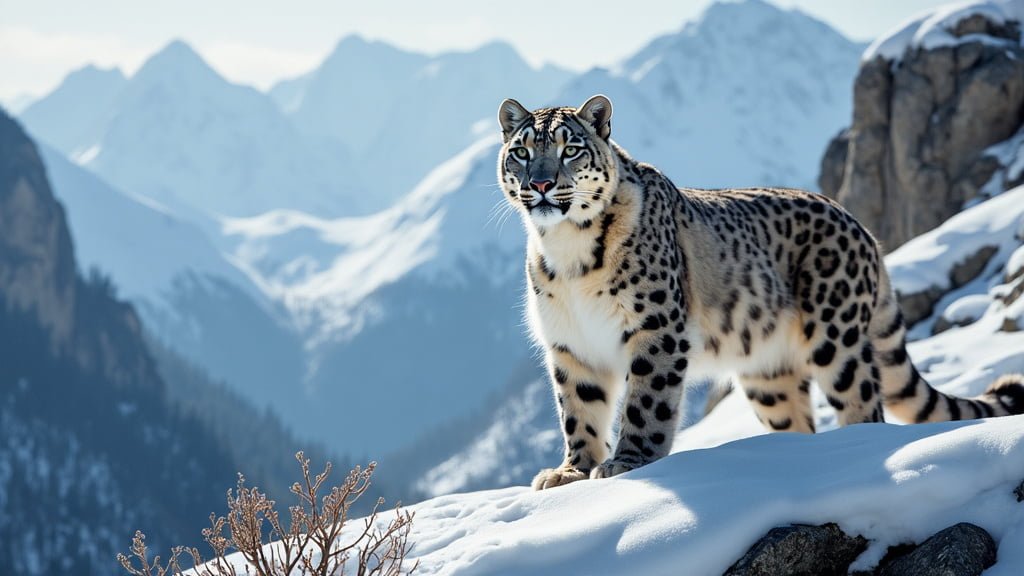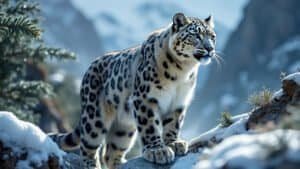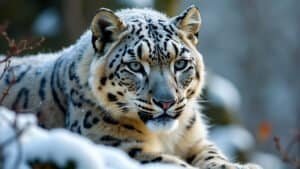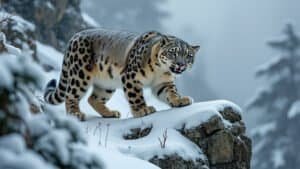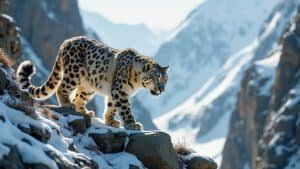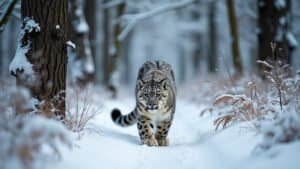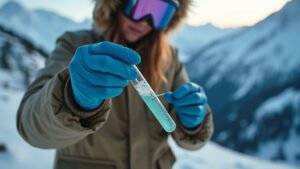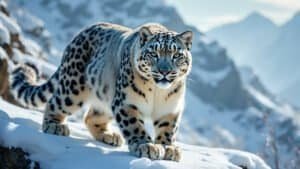Introduction
Snow leopards, known for their elusive nature and majestic presence in the high-altitude regions of Central Asia, face several threats, including habitat loss and poaching. However, an equally pressing issue is the impact of inbreeding on their genetics. Inbreeding, a common occurrence in small, isolated populations, can significantly affect genetic diversity, leading to numerous health and reproductive challenges
This article will explore the various impacts of inbreeding on snow leopard genetics, focusing on genetic diversity, health implications, reproductive effects, and ongoing conservation efforts to mitigate these risks
Genetic Diversity and Inbreeding in Snow Leopards
Genetic diversity is crucial for the survival of any species, providing the raw material for adaptation to changing environments. In snow leopards, a species already under threat due to habitat fragmentation, poaching, and climate change, maintaining genetic diversity is vital. Inbreeding, however, poses a significant risk to this diversity
When individuals within a population are closely related, the probability of inheriting identical copies of genes from both parents increases, leading to reduced genetic variability
This section will delve into the importance of genetic diversity, the concept of the inbreeding coefficient, and population genetics studies relevant to snow leopards
Importance of Genetic Diversity
Genetic diversity acts as a buffer against environmental changes, diseases, and other challenges that a species might face. In the case of snow leopards, which inhabit a range of environments from Mongolia’s rugged mountains to the steep slopes of the Himalayas, this diversity allows populations to adapt to local conditions
A higher level of genetic variability ensures that there are enough different alleles within the gene pool, enabling some individuals to survive when faced with new threats like diseases or climate shifts. For snow leopards, losing this genetic diversity due to inbreeding can reduce their ability to adapt, making populations more vulnerable to extinction
Studies have shown that in small, isolated populations, such as those of snow leopards in certain parts of Central Asia, genetic diversity tends to decrease over time. This is because the gene pool is limited, and individuals are more likely to mate with relatives, which can lead to a phenomenon known as genetic drift
Genetic drift further reduces the genetic variation within the population, leading to the fixation of certain alleles and the loss of others, which diminishes the population’s overall genetic health
Inbreeding Coefficient in Snow Leopards
The inbreeding coefficient is a measure of how closely related the individuals in a population are. It quantifies the probability that an individual has inherited two identical copies of a gene from an ancestor that appears on both the paternal and maternal sides of its family tree
For snow leopards, this coefficient can provide insight into how much inbreeding is occurring within a particular population and what the potential risks might be
In isolated snow leopard populations, particularly those in the Himalayas and other remote mountain ranges, inbreeding coefficients have been found to be relatively high
According to a study by Palomares and Roques (2017), the inbreeding coefficient in some snow leopard populations can reach levels that significantly reduce genetic diversity, making these populations more susceptible to inbreeding depression—a decline in fitness and survival caused by inbreeding
High inbreeding coefficients in snow leopard populations can lead to the expression of deleterious recessive alleles, which might otherwise remain hidden in a genetically diverse population. This can result in an increase in genetic disorders and other health-related issues that affect the overall viability of the population
Population Genetics Studies
Several population genetics studies have been conducted to understand the extent of inbreeding in snow leopard populations and its impact on their genetic health
For instance, Johansson et al. (2020) conducted a comprehensive study on isolated snow leopard populations across Central Asia. Their research highlighted that populations with higher inbreeding coefficients showed significantly reduced genetic diversity, which correlated with poorer health outcomes and lower reproductive success
Another study by Jackson and Hunter (2018) focused on snow leopard populations in the Himalayas, revealing that these isolated groups have been experiencing a steady decline in genetic diversity due to habitat fragmentation and inbreeding
The study emphasized the urgent need for conservation strategies that enhance genetic exchange between fragmented populations to prevent further inbreeding and loss of genetic diversity
These studies underscore the importance of maintaining genetic connectivity between snow leopard populations. By ensuring that individuals from different populations can interbreed, conservationists can help preserve the genetic diversity necessary for the species’ long-term survival
Health Implications of Inbreeding
Inbreeding, while increasing the genetic uniformity of a population, often brings with it a suite of negative health consequences. For snow leopards, these consequences can manifest as both physical and physiological issues, ultimately threatening the survival of the species
This section will explore the common genetic disorders associated with inbreeding, the impact of inbreeding on physical health and longevity, and specific case studies that illustrate these effects in snow leopards
Common Genetic Disorders in Inbred Snow Leopards
One of the most direct consequences of inbreeding is the increased likelihood of genetic disorders. In inbred populations, the probability of two copies of a deleterious recessive allele coming together in an individual increases, leading to the expression of harmful genetic conditions
For snow leopards, this can result in a range of disorders, including congenital deformities, immune system deficiencies, and reproductive issues
A significant concern in inbred snow leopards is the increased occurrence of genetic defects that affect their skeletal system. Studies have reported cases of skeletal malformations, such as limb deformities, which can impair the animal’s ability to hunt and survive in the wild. Additionally, inbred snow leopards are more prone to heart defects, which can reduce their lifespan and overall fitness
Moreover, inbreeding can lead to compromised immune systems, making snow leopards more susceptible to diseases. In a population with low genetic diversity, there is a higher chance that individuals will share similar immune system genes, reducing the population’s ability to fight off various pathogens
This lack of genetic variability in immune responses can lead to increased mortality rates during disease outbreaks
Impact on Physical Health and Longevity
Inbreeding has a profound impact on the physical health and longevity of snow leopards. As genetic disorders become more prevalent in inbred populations, individuals often suffer from chronic health problems that reduce their quality of life and lifespan
For example, heart defects and skeletal malformations not only hinder their ability to hunt but also make them more vulnerable to injuries and accidents in the rugged terrain they inhabit
Inbreeding can also lead to a phenomenon known as inbreeding depression, where the overall fitness of a population decreases due to the accumulation of deleterious alleles
This can result in reduced vitality, lower reproductive success, and higher mortality rates, all of which contribute to the population’s decline. In snow leopards, this has been observed in populations where inbreeding coefficients are high, leading to concerns about the long-term viability of these groups
A study conducted by Mishra et al. (2019) highlighted the link between inbreeding and reduced longevity in snow leopards. The study found that inbred individuals had shorter lifespans compared to their outbred counterparts, largely due to the compounded effects of genetic disorders and weakened health
This reduced longevity further exacerbates the decline of already endangered populations, making conservation efforts even more critical
Case Studies of Inbreeding Effects
To understand the real-world impacts of inbreeding on snow leopards, several case studies have been conducted. One such study focused on a small population of snow leopards in a remote region of Mongolia
Over several generations, the population became increasingly inbred due to geographic isolation and limited mating options. Researchers observed a rise in genetic disorders, including cleft palates and congenital heart defects, which severely impacted the population’s overall health
Another case study conducted in the Indian Himalayas revealed similar findings. The isolated population showed signs of inbreeding depression, with individuals exhibiting lower reproductive success and higher rates of juvenile mortality. These effects were directly linked to the population’s high inbreeding coefficient, which had increased steadily over the years due to a lack of genetic exchange with other populations
These case studies underscore the critical need for conservation strategies that address the genetic health of snow leopard populations. By facilitating genetic exchange between isolated groups, conservationists can help reduce the prevalence of inbreeding and its associated health impacts, ultimately improving the long-term survival prospects of this iconic species
Reproductive and Behavioral Impacts
Inbreeding not only affects the physical health of snow leopards but also has significant consequences on their reproductive success and behavior. These impacts can further jeopardize the survival of already vulnerable populations
This section will discuss how inbreeding affects the reproductive capabilities of snow leopards, the behavioral changes that can result from a lack of genetic diversity, and the long-term implications for the species’ survival
Reproductive Success in Inbred Populations
Reproductive success is a key determinant of a population’s ability to sustain itself. In snow leopards, as in other species, inbreeding can reduce reproductive success in several ways
One of the most significant effects is a decrease in fertility. Inbred individuals are more likely to suffer from reproductive issues such as reduced sperm quality in males and higher rates of infertility in females
Inbreeding can also lead to an increase in the occurrence of congenital defects in offspring, which not only reduces the chances of survival for these young leopards but also places a greater reproductive burden on the population. For instance, in an inbred population, a female snow leopard may have multiple offspring with genetic defects, leading to a lower overall reproductive output as these offspring are less likely to survive to adulthood
Moreover, inbreeding can result in lower birth weights and smaller litter sizes, both of which contribute to decreased population growth rates
A study by McCarthy and Mallon (2016) documented cases where inbred snow leopard populations had significantly lower reproductive success compared to populations with greater genetic diversity. These findings highlight the critical role that genetic diversity plays in ensuring the reproductive health of snow leopard populations
Behavioral Changes Due to Inbreeding
In addition to its effects on physical and reproductive health, inbreeding can also influence the behavior of snow leopards. Behavioral changes in inbred animals are often linked to the reduced functionality of the nervous system, which can affect their ability to survive and reproduce
One of the behavioral consequences of inbreeding observed in snow leopards is increased docility and reduced aggressiveness. While this might seem advantageous in some contexts, in the wild, it can reduce the animal’s ability to compete for mates, defend territory, and hunt effectively. This reduced competitiveness can lead to lower reproductive success and decreased survival rates
Furthermore, inbred snow leopards may exhibit abnormal social behaviors, such as reduced parental care. For instance, mothers might be less attentive to their cubs, leading to higher cub mortality rates
Behavioral studies, like those conducted by Jackson and Hunter (2018), have shown that inbred snow leopards in captivity tend to have higher instances of such abnormal behaviors, which could be indicative of similar issues in wild populations
Inbreeding may also lead to cognitive deficits, affecting the snow leopard’s ability to navigate its environment, hunt, and avoid predators. These cognitive impairments can have severe consequences for survival, particularly in the harsh and unforgiving environments where snow leopards live
Long-Term Survival Implications
The long-term implications of inbreeding on snow leopards are deeply concerning, particularly given the species’ already precarious status
The cumulative effects of reduced reproductive success, physical health problems, and behavioral changes can lead to a decline in population numbers and a reduced ability for populations to recover from environmental pressures
In small, isolated populations, the effects of inbreeding can create a vicious cycle where declining numbers lead to further inbreeding, exacerbating the negative impacts on genetic health. This cycle, if not broken, can push populations towards local extinction
In the case of snow leopards, this risk is particularly high in areas where human activities have fragmented habitats, preventing the natural migration and gene flow that would normally mitigate the effects of inbreeding
Conservation efforts must prioritize strategies that increase genetic diversity within snow leopard populations. This can include creating wildlife corridors that connect isolated populations, translocating individuals to introduce new genetic material, and implementing breeding programs that carefully manage genetic diversity
Without such interventions, the long-term survival of snow leopards in the wild could be severely compromised
Conservation Efforts and Genetic Management
Conservation of snow leopards is a complex challenge, particularly when addressing the genetic impacts of inbreeding. Effective conservation strategies must not only focus on habitat preservation but also on maintaining and enhancing genetic diversity within snow leopard populations
This section will explore current conservation strategies aimed at reducing inbreeding, genetic monitoring and management programs, and future directions in snow leopard conservation
Current Conservation Strategies
To combat the genetic consequences of inbreeding, several conservation strategies have been implemented across the snow leopard’s range. One of the primary strategies is the establishment of protected areas and wildlife corridors that facilitate gene flow between isolated populations
These corridors are crucial in connecting fragmented habitats, allowing snow leopards to migrate and interbreed with individuals from different populations, thereby enhancing genetic diversity
Protected areas, such as national parks and wildlife reserves, also play a vital role in snow leopard conservation. These areas provide a safe haven from poaching and human encroachment, helping to stabilize populations
However, simply protecting habitats is not enough; active management is required to ensure that these populations remain genetically viable. This includes monitoring the genetic health of snow leopards within these areas and taking steps to prevent inbreeding from becoming a significant issue
In addition to habitat protection, captive breeding programs have been established in various zoos and conservation centers around the world. These programs are designed to maintain a genetically diverse captive population that can serve as a genetic reservoir for the species
By carefully managing breeding to avoid inbreeding, these programs can help ensure that snow leopards in captivity maintain a healthy level of genetic diversity, which could be vital for future reintroduction efforts
Genetic Monitoring and Management Programs
Genetic monitoring is a critical component of snow leopard conservation, providing the data needed to assess the genetic health of populations and make informed management decisions
Advances in genetic technologies have made it possible to analyze the DNA of snow leopards from non-invasive samples, such as scat, hair, or skin. This allows researchers to estimate inbreeding levels, assess genetic diversity, and identify individuals with valuable genetic traits
One of the key tools used in genetic monitoring is the analysis of the inbreeding coefficient across different populations. By regularly monitoring this coefficient, conservationists can identify populations at risk of inbreeding depression and take proactive measures to mitigate these risks
For example, if a population is found to have a high inbreeding coefficient, conservationists might introduce individuals from a genetically distinct population to increase diversity
In addition to monitoring, genetic management programs are essential for maintaining the long-term genetic health of snow leopards. These programs involve carefully planned translocations, where individuals from genetically diverse populations are introduced to areas where inbreeding is a concern
This not only increases genetic diversity but also helps to restore the genetic flow that might have been disrupted by habitat fragmentation
Furthermore, international collaborations, such as the Global Snow Leopard & Ecosystem Protection Program (GSLEP), play a significant role in coordinating conservation efforts across the snow leopard’s range. These collaborations enable the sharing of genetic data, research findings, and best practices, ensuring that conservation strategies are informed by the latest scientific knowledge
Future Directions in Snow Leopard Conservation
Looking ahead, the future of snow leopard conservation will depend on a combination of traditional conservation strategies and innovative approaches to genetic management. One promising area of research is the use of genomic tools to better understand the genetic structure of snow leopard populations
By sequencing the genomes of snow leopards from different regions, researchers can gain insights into the genetic variations that are most critical for the species’ survival and adaptability
Another important direction is the integration of genetic data into conservation planning at a landscape level. This involves using genetic information to identify priority areas for conservation, such as regions with high genetic diversity or areas that serve as critical genetic corridors between populations
By focusing conservation efforts on these key areas, it may be possible to maximize the genetic health of snow leopard populations across their entire range
Additionally, there is a growing emphasis on community-based conservation, where local communities are actively involved in the protection of snow leopards and their habitats. These initiatives not only help to reduce human-wildlife conflicts but also ensure that conservation efforts are sustainable in the long term
By empowering local communities to take part in conservation, it becomes easier to implement measures that protect both the snow leopard and its genetic diversity
Finally, climate change presents a new set of challenges for snow leopard conservation. As temperatures rise and habitats shift, snow leopards may be forced to move to new areas, potentially leading to further habitat fragmentation and genetic isolation
Conservation strategies will need to be adaptive, incorporating climate models to predict future habitat changes and ensuring that snow leopards can continue to migrate and maintain genetic diversity in a changing world
Conclusion
Inbreeding poses a significant threat to the genetic health and long-term survival of snow leopards, a species already vulnerable due to habitat loss, poaching, and climate change
As discussed, inbreeding leads to a reduction in genetic diversity, resulting in various health issues, decreased reproductive success, and behavioral changes that can jeopardize population viability. The consequences of inbreeding are evident in the physical deformities, compromised immune systems, and cognitive deficits observed in affected populations
To counter these impacts, it is crucial to implement conservation strategies that prioritize genetic diversity. Protected areas, wildlife corridors, and captive breeding programs are vital components of these efforts, helping to maintain and enhance genetic connectivity between isolated snow leopard populations
Additionally, genetic monitoring and management programs provide the necessary data to guide conservation actions, ensuring that populations remain genetically healthy
Looking ahead, the integration of advanced genomic tools, community-based conservation initiatives, and adaptive strategies that account for climate change will be essential in safeguarding the future of snow leopards. By addressing the genetic challenges posed by inbreeding, we can improve the resilience of snow leopard populations and support their continued survival in the wild
